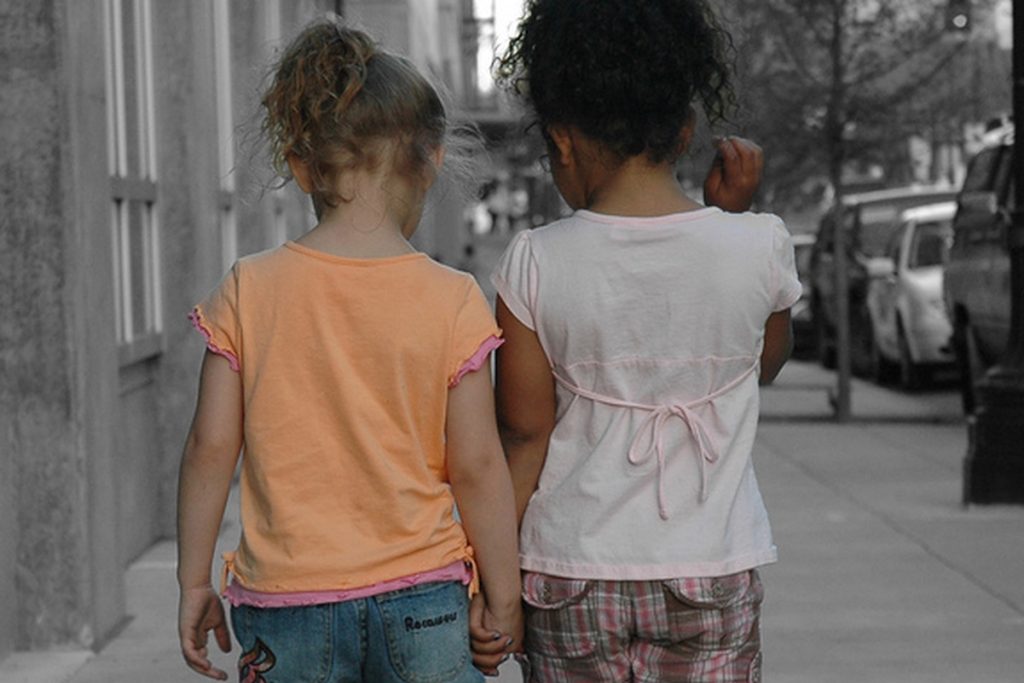WaTasha Barnes Griffin story written by Seth Carrier-Ladd
Tasha is 41 years old
“Madeline, what ‘choo doin?” That was the moment everything changed.
Madeline was my best friend. We’d known each other since we met in kindergarten, delighted when we figured out that we lived across the street from each other. We noticed, of course, that our skin was a different color – Madeline’s white, mine black – but that didn’t matter to me, and it didn’t matter to her. I mean we noticed, right? After we became friends, we asked, “Can I touch your skin and see if it feels different?” Which it didn’t really. And of course, “Can I touch your hair?” Which did actually feel different. But outside of those natural curiosities that any kid of that age has, we pretty much just played.
Now I didn’t play with Madeline all of the time. Our street was the dividing line. So I always had to choose – out the front door to the white neighborhood, or out the back door to the black. Two doors in one house, in my house, each door leading to a totally different kind of place. I liked both – safe and at home with my black friends out back, different and interesting white friends out front.
My black friends didn’t understand. “Why you wanna’ hang out with the white kids?” they would ask. “Madeline’s my friend,” I would respond, and leave it at that. My grandmother, she’d have white friends over for dinner every so often, and our pastor, he talked all the time at church about how important it was to have friends of every color. And we went to the same school as all these white kids. So their questions didn’t even make sense to me. Of course I wanted to hang out with Madeline. She was my friend. I didn’t get it.
Truthfully, the difference I noticed more between me and Madeline was about class. Madeline’s folks were poor as could be, despite living on the white side of the street. And while we weren’t “well off” at my grandmother’s house, we always had enough, we always had everything we needed, and we certainly had more than enough love.
You could see the difference just looking at our two houses. Plunked down between two more well-kept houses, a green one on one side, and a yellow one on the other, Madeline’s dark gray-colored house looked worn. It had a light gray picket fence around its front yard, with the paint flaking and chipped off in places, and the yard was all dirt. No grass in Madeline’s front yard, just dirt. Dirt, and two green metal chairs, that rocked a bit when you sat in them. And the front porch – can’t forget that porch. Covered in junk, end-to-end, from who knows where.
Our house on the other hand, was proud. Two-stories of brick, with a well-kept front yard, nice pine shrubs on either side of front steps, pillars on the front porch, and of course a few pieces of nice patio furniture. The class difference showed in other ways too. The way we dressed, for example – my clothes were usually in better shape. Now, we didn’t care, we played in Madeline’s dirt front yard with the green chairs just as often if not more than we played on the nice front porch at my grandmother’s house, and we didn’t talk about clothes. But we noticed, or at least I did.
Sometimes I would ask my mama, “Mom, you know those shoes that I don’t wear anymore? Can I give them to Madeline… she really needs some shoes.” It only made sense, Madeline was my friend, and she needed stuff, and I had stuff that I wasn’t using.
And so we continued merrily on our way. It wasn’t perfect. No friendship ever is. We had our little fights and disagreements, but never about the color of our skin. And we always worked it out. Kindergarten through fourth grade was pretty great. And then one day everything changed.
It was a nice sunny day. We were sitting out in Madeline’s dirt front yard, near those green metal chairs, that peeling gray picket fence. We were sitting there playing with dolls – white baby dolls. Two little girls playing, not a care in the world, and then some white man I didn’t know, a friend of the neighbors in the yellow house, he shouted out,
“Madeline, what ‘choo doin?
“Just playin’.”
“Why you playin’ with a nigger?”
“This isn’t a nigger, this is Tasha.”
Looking back, I’m glad that white man didn’t push it any further. He just walked away, and Madeline asked, “What’s a nigger?”
“He’s talking about black people.”
And we left it at that.
Now I don’t know if Madeline talked to her parents, but I talked to my mom as soon as I got home, and told her what happened. “It made me feel bad mom. It hurt my feelings.”
“Oh honey. Some people are just like that. Some people see color instead of seeing people for who they really are. In our family, we treat people they we want to be treated – with kindness, love and respect. You’re beautiful. You’re smart. You’re intelligent. You’re my Tasha.”
“But sometimes other black people call each other nigger… why do they do that?”
“They shouldn’t do it honey. No one should ever call each other by that name.”
What she didn’t say to me then was as important as what she did. She didn’t tell me “No more going back over there to play with Madeline.” She never said, “You stay away from the white side of the street.” She just explained and supported. And so the next day, back I went, to play dolls again with my best friend.
I’ve never forgotten though. Before, I knew about black and white. After, black and white meant BLACK and WHITE.
The thing is – I’ve never really changed. I’ve experienced my fair share of racism, so much so in fact that I usually just tune out the consistent, regular, repetitive low-level stuff. But the color of a person’s skin still doesn’t matter to me. I see it, I know it makes a difference, I talk to my two black children about how America treats them differently as a black person because I have to… but when I meet people, skin color is one of the last things I notice. Just like with Madeline, I see people, I see human beings, I see my friends.
Skin color shouldn’t matter. That’s the way it should be. We have to keep putting in the work to make it so.
Read the original story on the RACE Muncie Facing Project Page
—-
Are you interested in seeing more stories like this? If so, we need your help. Check out the Build Empathy Story-By-Story Campaign to learn how you can plug into the work of The Facing Project.
About The Facing Project:
The Facing Project is a 501(c)(3) nonprofit organization that connects people through stories to strengthen communities. The organization’s model to share stories and raise awareness is in cities across the United States focused on topics such as poverty, sex trafficking, mental health, immigration, and more. Facing Project stories are compiled into books and on the web for a community resource, used to inspire art, photography, monologues and—most importantly—community-wide awareness, dialogue, action, and change toward a more understanding and empathetic society.


